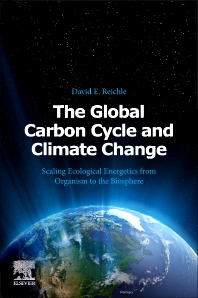LIMITED OFFER
Save 50% on book bundles
Immediately download your ebook while waiting for your print delivery. No promo code is needed.

Book sale: Save up to 25% on print and eBooks. No promo code needed.
Save up to 25% on print and eBooks.
1st Edition - November 8, 2019
Author: David E. Reichle
The Global Carbon Cycle and Climate Change examines the global carbon cycle and the energy balance of the biosphere, following carbon and energy through increasingly complex… Read more

LIMITED OFFER
Immediately download your ebook while waiting for your print delivery. No promo code is needed.

The Global Carbon Cycle and Climate Change examines the global carbon cycle and the energy balance of the biosphere, following carbon and energy through increasingly complex levels of metabolism from cells to ecosystems. Utilizing scientific explanations, analyses of ecosystem functions, extensive references, and cutting-edge examples of energy flow in ecosystems, it is an essential resource to aid in understanding the scientific basis of the role played by ecological systems in climate change.
This book addresses the need to understand the global carbon cycle and the interrelationships among the disciplines of biology, chemistry, and physics in a holistic perspective. The Global Carbon Cycle and Climate Change is a compendium of easily accessible, technical information that provides a clear understanding of energy flow, ecosystem dynamics, the biosphere, and climate change.
"Dr. Reichle brings over four decades of research on the structure and function of forest ecosystems to bear on the existential issue of our time, climate change. Using a comprehensive review of carbon biogeochemistry as scaled from the physiology of organisms to landscape processes, his analysis provides an integrated discussion of how diverse processes at varying time and spatial scales function. The work speaks to several audiences. Too often students study their courses in a vacuum without necessarily understanding the relationships that transcend from the cellular process, to organism, to biosphere levels and exist in a dynamic atmosphere with its own processes, and spatial dimensions. This book provides the template whereupon students can be guided to see how the pieces fit together. The book is self-contained but lends itself to be amplified upon by a student or professor. The same intellectual quest would also apply for the lay reader who seeks a broad understanding." --W.F. Harris
Environmental scientists, economists, corporate sustainability professionals, policy makers
1. An Introduction to Ecological Energetics and the Global Carbon Cycle2. The Physical and Chemical Bases of Energy3. Energy Relationships between Organisms and the Environment4. Biological Energy Transformations by Plants5. Energy Processing by Animals6. Species Adaptations to their Energy Environment7. Food Chains and Trophic Level Transfers8. Energy Flow in Ecosystems9. Ecosystem Productivity10. The Global Carbon Cycle and the Biosphere11. Anthropogenic Alterations to the Global Carbon Cycle and Climate Change12. Carbon, Climate Change, and Public Policy
DR